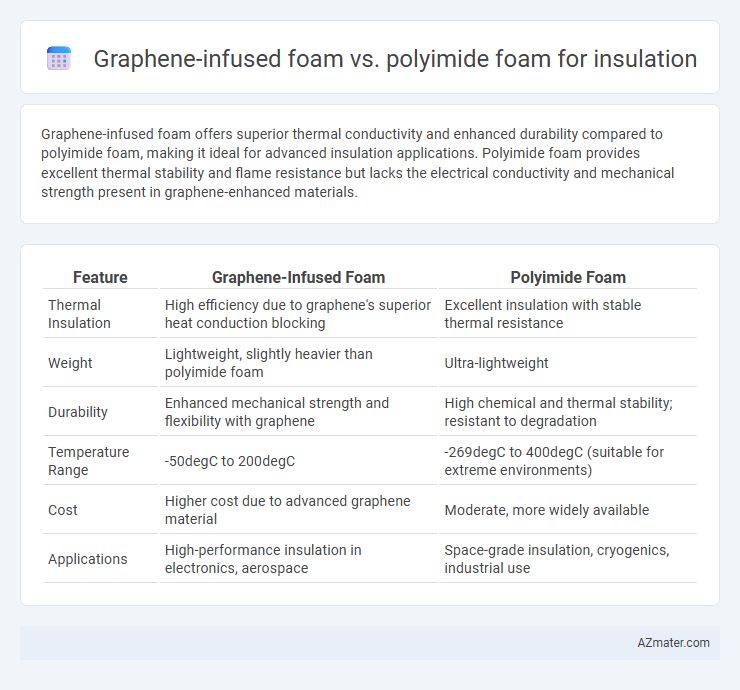Graphene-infused foam offers superior thermal conductivity and enhanced durability compared to polyimide foam, making it ideal for advanced insulation applications. Polyimide foam provides excellent thermal stability and flame resistance but lacks the electrical conductivity and mechanical strength present in graphene-enhanced materials.
Table of Comparison
| Feature | Graphene-Infused Foam | Polyimide Foam |
|---|---|---|
| Thermal Insulation | High efficiency due to graphene's superior heat conduction blocking | Excellent insulation with stable thermal resistance |
| Weight | Lightweight, slightly heavier than polyimide foam | Ultra-lightweight |
| Durability | Enhanced mechanical strength and flexibility with graphene | High chemical and thermal stability; resistant to degradation |
| Temperature Range | -50degC to 200degC | -269degC to 400degC (suitable for extreme environments) |
| Cost | Higher cost due to advanced graphene material | Moderate, more widely available |
| Applications | High-performance insulation in electronics, aerospace | Space-grade insulation, cryogenics, industrial use |
Introduction to Advanced Foam Insulation Materials
Graphene-infused foam offers superior thermal conductivity and enhanced mechanical strength compared to traditional insulators, making it an innovative choice for advanced foam insulation applications. Polyimide foam stands out due to its exceptional thermal stability, low density, and flame-retardant properties, widely utilized in aerospace and electronics insulation. Both materials represent cutting-edge advancements in insulation technology, addressing high-performance demands with unique conductive and protective characteristics.
What is Graphene-Infused Foam?
Graphene-infused foam is an advanced insulation material incorporating graphene nanoparticles into conventional foam to enhance thermal conductivity and mechanical strength. This innovative composite offers superior thermal insulation performance and improved durability compared to traditional polyimide foam, which is widely used for its lightweight and high-temperature resistance. The integration of graphene significantly lowers heat transfer rates while maintaining flexibility, making it ideal for applications requiring efficient thermal management and structural resilience.
Understanding Polyimide Foam
Polyimide foam offers exceptional thermal stability and low thermal conductivity, making it a superior insulation material for high-temperature applications compared to graphene-infused foam. Its inherent chemical resistance, lightweight nature, and low outgassing properties render polyimide foam ideal for aerospace and electronics insulation. While graphene-infused foam enhances mechanical strength and thermal conductivity, polyimide foam excels in maintaining insulation effectiveness under extreme thermal and chemical conditions.
Thermal Insulation Properties: A Comparative Overview
Graphene-infused foam exhibits superior thermal conductivity reduction compared to polyimide foam, enhancing its performance as an insulator in extreme temperature environments. Polyimide foam offers excellent thermal stability and low thermal conductivity, but graphene's exceptional heat dissipation properties enable graphene-infused foams to maintain lower thermal transfer rates under similar conditions. The integration of graphene significantly improves the thermal insulation efficiency by decreasing heat flow and increasing thermal resistance relative to standard polyimide foam.
Mechanical Strength and Durability Analysis
Graphene-infused foam exhibits superior mechanical strength compared to polyimide foam, owing to graphene's exceptional tensile strength and stiffness, which enhances the composite's load-bearing capacity and resistance to deformation. Durability analysis reveals that graphene-infused foam maintains structural integrity under prolonged mechanical stress, high temperature, and cyclic loading better than polyimide foam, which is prone to gradual degradation and loss of mechanical properties over time. The integration of graphene nanoparticles in foam matrices significantly improves wear resistance and reduces fatigue, making graphene-infused foam a more reliable insulation material for demanding environments.
Fire Resistance: Safety Performance Compared
Graphene-infused foam exhibits superior fire resistance compared to polyimide foam due to its enhanced thermal conductivity and ability to dissipate heat rapidly, reducing combustion risk. Polyimide foam provides excellent thermal stability and inherent flame retardancy but may degrade at higher temperatures over prolonged exposure. Graphene's unique structure reinforces foam integrity during fires, significantly improving safety performance in insulation applications.
Weight and Flexibility: Impacts on Application
Graphene-infused foam offers significantly lower weight compared to polyimide foam, enhancing portability and ease of installation in aerospace and wearable technologies. Its superior flexibility allows it to conform better to complex shapes, improving thermal insulation performance in dynamic environments. Polyimide foam, while lightweight and thermally stable, lacks the same level of pliability, limiting its use in applications requiring extensive bending or compression.
Environmental Impact and Sustainability Factors
Graphene-infused foam offers superior thermal conductivity and durability while maintaining lightweight properties, reducing energy consumption in insulation applications and lowering carbon footprint. Polyimide foam, known for its excellent thermal stability and chemical resistance, is less energy-intensive to produce but often relies on non-renewable petrochemical sources, impacting sustainability negatively. Considering end-of-life disposal, graphene-infused foam's potential for recyclability and reduced material usage enhances environmental sustainability compared to traditional polyimide foam insulation solutions.
Cost-Effectiveness and Market Availability
Graphene-infused foam offers superior thermal conductivity and durability compared to polyimide foam, though its higher production costs limit widespread market availability, impacting overall cost-effectiveness for large-scale insulation projects. Polyimide foam remains more cost-effective due to established manufacturing processes and broad market access, making it a preferred choice for standard insulation applications despite lower performance metrics. The balance between performance benefits and pricing makes polyimide foam more accessible, while graphene-infused foam targets niche markets demanding advanced thermal management solutions.
Choosing the Best Foam for Your Insulation Needs
Graphene-infused foam offers superior thermal conductivity and mechanical strength compared to polyimide foam, making it ideal for applications requiring enhanced heat dissipation and durability. Polyimide foam provides excellent thermal stability and fire resistance, suitable for environments with high-temperature exposure and stringent safety standards. Choosing the best insulation foam depends on balancing graphene-infused foam's advanced performance benefits against polyimide foam's proven thermal resilience and regulatory compliance.

Infographic: Graphene-infused foam vs Polyimide foam for Insulation
 azmater.com
azmater.com